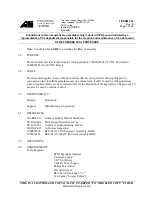
OPERATOR’S MANUAL
ISO
6
Version 4 UL 2_3 Manual
LIMIT OUTPUT / 101
6011258 Rev C
LIMIT OUTPUT
It is necessary to limit the output of the control channel before
running a valve calibration in the event that system capacities
are greater than the actual desired capacities. These features
allow setting the maximum output of the channel to prevent
machine damage.
PERFORM A LIMIT OUTPUT:
1. At the Valve Calibration screen, press the
LIMIT OUTPUT
button.
2.
Move the implement to the “raised” position.
3. Apply the tractor brakes and lock in the applied position.
4.
Put the transmission in “park” or in a locked, neutral position.
5. Engage hydraulic system.
6. Run engine at normal operating RPM until hydraulic fluid is
at normal operating temperature.
7. To change the valve position, press the Increment or
Decrement buttons repeatedly until the desired maximum
output value is reached.
8. Press the
START
button and the valve calibration
immediately begins.
The calibration runs using the new max flow value.
K-FACTOR CALIBRATION
NOTE
Refer to the System Tests section for using a remote test
switch during a K-Factor calibration.
To determine the actual K-Factor of a system, water should be
dispensed through the system and measured. The calibration
procedure will accumulate the pulse. At the end of the calibration
procedure, the operator enters the amount dispensed. This
number becomes the actual K-Factor instead of the one
stamped on the flow meter body. The more liquid passing
through the system during calibration increases the degree
of K-Factor accuracy.
100% CATCH TEST
This is the recommended method because a larger volume of
liquid passes through the entire sprayer system making errors in
weighing a smaller factor.
1. Fill the tank and weigh the load.
2. Activate the calibration routine.
3. After spraying a few hundred gallons but before the load is
empty, stop the calibration.
4. Weigh the load again.
5. Calculate gallons dropped.
















































